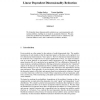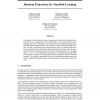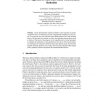ICASSP
2011
IEEE
13 years 11 months ago
2011
IEEE
A K∗ -sparse vector x∗ ∈ RN produces measurements via linear dimensionality reduction as u = Φx∗ + n, where Φ ∈ RM×N (M < N), and n ∈ RM consists of independent ...
ICASSP
2011
IEEE
13 years 11 months ago
2011
IEEE
We consider the problem of classification of a pattern from multiple compressed observations that are collected in a sensor network. In particular, we exploit the properties of r...
PAMI
2008
14 years 6 months ago
2008
We present a novel probabilistic latent variable model to perform linear dimensionality reduction on data sets which contain clusters. We prove that the maximum likelihood solution...
NIPS
2003
14 years 8 months ago
2003
We formulate linear dimensionality reduction as a semi-parametric estimation problem, enabling us to study its asymptotic behavior. We generalize the problem beyond additive Gauss...
NIPS
2007
14 years 8 months ago
2007
We propose a novel method for linear dimensionality reduction of manifold modeled data. First, we show that with a small number M of random projections of sample points in RN belo...
CIARP
2006
Springer
14 years 11 months ago
2006
Springer
Linear dimensionality reduction (LDR) is quite important in pattern recognition due to its efficiency and low computational complexity. In this paper, we extend the two-class Chern...
CIARP
2006
Springer
14 years 11 months ago
2006
Springer
Abstract. A theoretical analysis for comparing two linear dimensionality reduction (LDR) techniques, namely Fisher's discriminant (FD) and Loog-Duin (LD) dimensionality reduci...
AI
2006
Springer
14 years 11 months ago
2006
Springer
Abstract. We present a performance analysis of three linear dimensionality reduction techniques: Fisher's discriminant analysis (FDA), and two methods introduced recently base...



